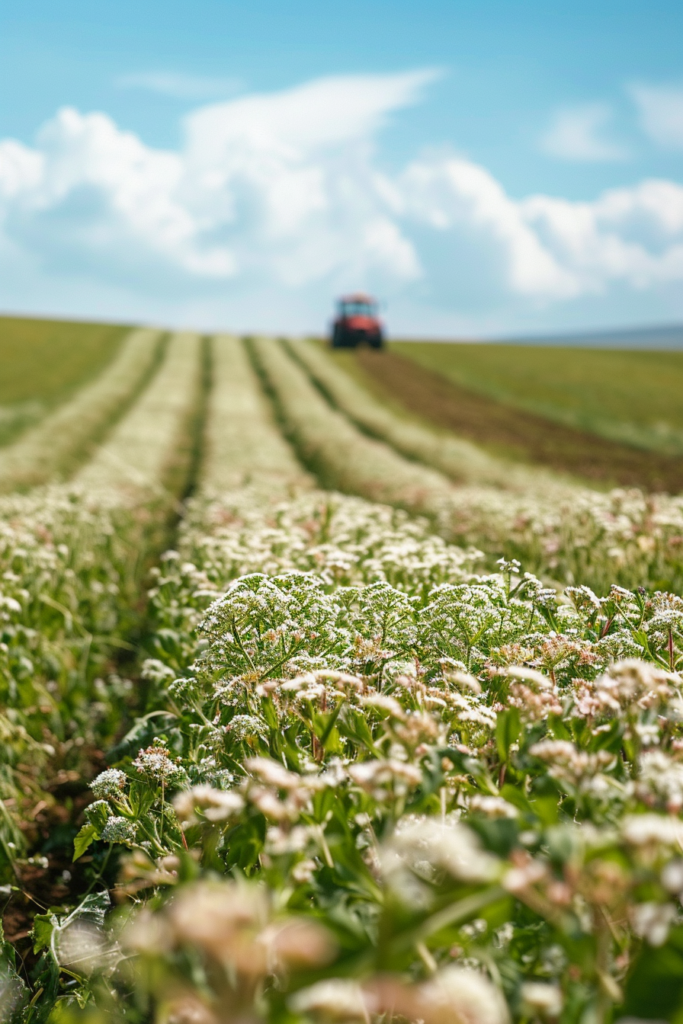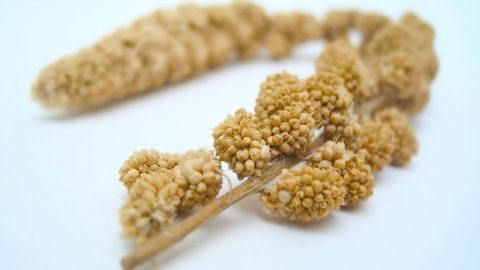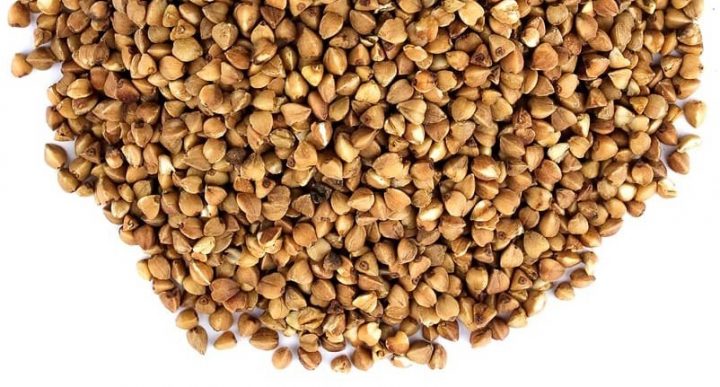 One of the most common questions from our customers is, “What is buckwheat?”
One of the most common questions from our customers is, “What is buckwheat?”
Buckwheat, or Fagopyrum tataricum, is a hearty plant bearing three sided grain-like seeds. At maturity it stands at between 2 and 4 feet tall. It flowers prolifically for two to three weeks. Then it produces hundreds of small brown seeds with high nutritional value. Each seed, or groat, is protected by a hard outer shell or hull much like a sunflower seed.
The buckwheat plant is one of the world’s first domesticated crops.
It’s thought that cultivation began in Southeast Asia around 5 or 6 thousand years ago. From there it spread to Central Asia, the Middle East, and then Europe. Buckwheat use was documented in Finland by at least 5300 BCE. It was finally brought to North America in the 1600s.

Buckwheat was a much more popular crop before the introduction of nitrogen fertilizers in the 20th century.
The industrial revolution delivered impressive new technologies to farms around the world. Notably, new fertilizers dramatically increased the productivity and profitability of other popular staples like wheat and maize. This advancement resulted in substantially reduced buckwheat production. As a result, in America, over a million acres of buckwheat were harvested in 1918. By 1954 production decreased to just 150, 000 acres.
It used to be that most of the buckwheat produced was used for livestock and poultry. However, today most buckwheat production is for human consumption. During the mid 1970s demand for new breakfast cereals and buckwheat noodles skyrocketed. This caused a surge in interest in buckwheat as food.
Building on this recent popularity, the marketing of “ancient grains” as healthy alternatives to traditional modern foods has made buckwheat a resurgent crop.
Russia, China and Kazakhstan are currently the world’s largest producers of buckwheat.
America is the 4th largest producer. In recent years America harvests about 75,000 acres annually. Most buckwheat grown in the USA comes from New York, Pennsylvania and North Dakota.
The majority of U.S. produced buckwheat is for the Japanese market. They love their soba noodles! For this reason, in 2013 Japan accounted for 96% of buckwheat exported from America!
Boekweit not wheat
Buckwheat’s name derives from the seed’s appearance, which resembles a seed of the beech tree. We can thank the Dutch for this insight: “boekweit,” means beech-wheat. Despite its name, buckwheat is not a type of wheat at all. It is actually part of the rhubarb family and is considered a fruit.
Buckwheat grows best in a cool moist climate, and can thrive in subpar earth. As a result, farmers like it because it’s easy and economical to produce. It requires little to no fertilizer or pesticides. It also requires minimal maintenance. Buckwheat grows very quickly, maturing in just 30 days. While in most respects, it’s easy to grow, buckwheat is sensitive to unfavorable weather conditions. It is killed quickly by frost and higher temperatures can prevent seed formation. Buckwheat can be susceptible to to drought as well due to its relatively short root system.
What is it used for?
Food (Soba Noodles, Kasha and Pancakes!)
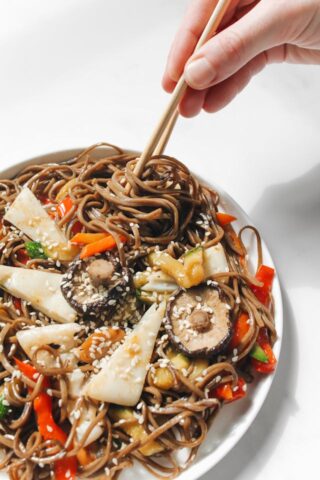
Buckwheat has long been utilized as a source of nutrition. Specifically, it contains a well balanced mix of starch, fat, protein and minerals. According to the USDA:
In a 100 gram serving, buckwheat provides 385 calories and is a rich source (20% or more of the Daily Value, DV) of protein, dietary fiber, four B vitamins and several dietary minerals, with content especially high (47 to 65% DV) in niacin, magnesium, manganese and phosphorus. Buckwheat is 72% carbohydrates, including 10% dietary fiber, 3% fat and 13% protein (table).
Source: USDA
It is naturally gluten-free, making it an excellent choice for those with celiac disease or gluten sensitivity. Rich in dietary fiber, buckwheat supports digestive health by promoting regular bowel movements and preventing constipation. Its high levels of antioxidants, such as rutin, quercetin, and phenolic acids, help combat oxidative stress and reduce inflammation in the body. Buckwheat is also a good source of plant-based protein, providing all essential amino acids, which are crucial for muscle repair and growth. Additionally, it contains important minerals like magnesium, manganese, and copper, which contribute to bone health, energy production, and immune function. Regular consumption of buckwheat can aid in managing blood sugar levels and improving cardiovascular health due to its low glycemic index and cholesterol-lowering properties.
Global Demand for Buckwheat: From Japanese Soba Noodles to Eastern European Kasha
Japan imports 100,000 metric tons of buckwheat annually. Most of this imported buckwheat is used specifically to produce soba, a popular type of thin noodle. Soba is a staple in Japanese cuisine and is enjoyed in various forms. It can be served chilled with a dipping sauce, known as “zaru soba,” or as a hot soup, “kake soba,” often garnished with green onions, tempura, or other ingredients. The versatility and nutritional benefits of buckwheat make it a valuable food source not only in Japan but around the world.
Food products sold in American markets are primarily processed flours, pancake mixes or breakfast cereals. In contrast, Eastern Europeans prefer their buckwheat boiled in water or milk, calling it kasha.
Buckwheat groats are a light brown color when fresh and removed from their hulls. The groats must be used quickly. Because their fat content is high, they can quickly become rancid. Thus, they’re generally sold within a few months of harvest. Within food markets, darker groats are considered to be less appealing and thus cheaper than fresher, lighter groats.
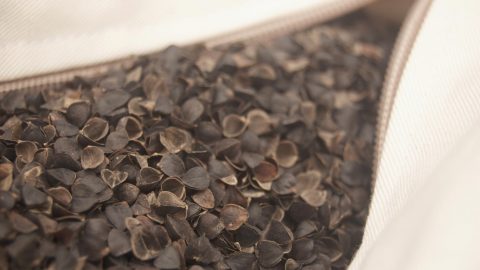
Buckwheat is also utilized as:
- pillow filling. That’s what we use it for! A buckwheat hull pillow will perfectly support the space beneath your neck, keeping your spine straight and allowing your neck and back muscles to completely relax. The hulls also allow air to move freely through your pillow, preventing uncomfortable heat build up. Don’t believe me? Check out these reviews from customer who have tried our buckwheat pillow!
- a cover crop. Buckwheat is often planted as a cover crop to manage erosion, soil quality, water, weeds, pests, diseases, and biodiversity. It is frequently used to prepare soil for organic crops. It crowds out weeds and it can add up to 3,000 pounds of organic material per acre.
- support for bee colonies. A single acre of can support a hive of bees producing up to 150 pounds of honey! It apparently produces a very unique and desirable flavor.
- livestock and poultry feed. Buckwheat is roughly comparable to oats in terms of nutritional value. It’s most suitable for cattle, but it’s fed to pigs as well. It’s often mixed with other feed types. This is because, interestingly, “light-skinned livestock (and humans) can develop a rash and possible complications if they are exposed to sunlight after eating a large amount of buckwheat.” Source: Missouri.edu
Sustainable Agriculture and Biodiversity
An important aspect often overlooked is the buckwheat plant’s role in promoting sustainable agriculture and biodiversity. It is renowned for its ability to thrive in poor soil conditions without the need for chemical fertilizers, making it a champion of low-impact farming. Its dense growth pattern suppresses weeds, reducing the necessity for herbicides, and its flowers are a valuable nectar source for pollinators, including bees and butterflies. Additionally, buckwheat’s ability to grow quickly and improve soil health by adding organic matter makes it an ideal crop for rotation and green manure.
Buckwheat is generally not a perennial plant, meaning it does not come back every year on its own. It is an annual crop, which means it completes its life cycle—from germination to the production of seeds—within one growing season and then dies. Farmers typically need to plant buckwheat seeds each year if they want to harvest it annually. However, buckwheat is known for its relatively short growing season, usually around 10-12 weeks, making it a popular choice for crop rotation and cover cropping due to its ability to quickly establish and improve soil health.
Buckwheat, though often viewed as a single crop, actually comprises several varieties, each with unique characteristics and uses.
The most commonly cultivated species are Fagopyrum esculentum, also known as common buckwheat, and Fagopyrum tataricum, or Tartary buckwheat. Common buckwheat is widely grown for its seeds, which are used in flour, noodles, and other food products. It is known for its relatively mild flavor and is the type most often found in Western markets. Tartary buckwheat, on the other hand, has a stronger, more bitter taste and is particularly rich in rutin, a beneficial antioxidant. This variety is often used in traditional medicines and health foods, especially in Asia. There are also other lesser-known species and local varieties cultivated in different regions, each adapted to specific climates and soil conditions. These variations not only contribute to the agricultural biodiversity of buckwheat but also offer a range of nutritional benefits and culinary possibilities.
Emerging Scientific Research on Health Benefits
Recent scientific studies have begun to uncover the broader health implications of consuming buckwheat. Its high content of flavonoids, particularly rutin, has been linked to improved blood circulation and the prevention of blood clots, offering potential cardiovascular benefits. Furthermore, research suggests that the unique composition of proteins in buckwheat may have bioactive properties that can aid in managing diabetes by influencing blood sugar levels. Buckwheat’s high fiber content also contributes to a healthy gut microbiome, which is vital for overall health and well-being. These emerging findings suggest that incorporating it into the diet may offer a range of health benefits beyond its already known nutritional value, making it a superfood worth exploring further.
Buckwheat Plant: Nutritional Powerhouse, Environmental Guardian and Cozy Pillow Filling
Now that you know what buckwheat is, give it a try. Pick up some buckwheat flour and cook some pancakes for your family this Saturday! Try some funky buckwheat honey on your toast!
Better yet: Try one of our supremely comfortable Hullo™ buckwheat pillows for 60 nights. If it isn’t for you, just send it back to us for a refund.
Additional Sources:
Allelopathy: New Concepts & Methodology edited by Y Fujii, Syuntaro Hiradate
Wikipedia: https://en.wikipedia.org/wiki/Buckwheat</a>
Alternative Field Crops Manual https://hort.purdue.edu/newcrop/afcm/buckwheat.html</a>
Systematic Review of Human and Animal Evidence on the Role of Buckwheat Consumption on Gastrointestinal Health https://www.mdpi.com/2072-6643/15/1/1
Advances in Buckwheat Research https://www.frontiersin.org/journals/plant-science/articles/10.3389/fpls.2023.1190090/full

